Making Cents of Electric Vehicles in the Driftless!

“Electricity is really just organized lightning…” -George Carlin
Story and photos by Benji Nichols, except as noted
Imagine pulling out onto the street as your foot leans into the accelerator. You move forward – silently – off on a trip to work, school, errands, or across the region. Now imagine not using a drop of gasoline to do it. Too good to be true? It’s not!
Electric vehicles (EVs) are not a new concept, but technological evolution and incredibly efficient operating costs are making EVs more realistic than ever for many households. Here at Inspire(d) HQ, we’ve been enjoying the rewards of our own solar PV array for the past year, and we’re constantly engaged in what technologies are coming on line to help lessen our immediate impacts on fossil fuel use. Sure, there’s an immediate ‘feel-good’ effect, but increasingly the technology is actually making economic sense as well. Ride along as we cruise through our latest road-trip into electric vehicles.
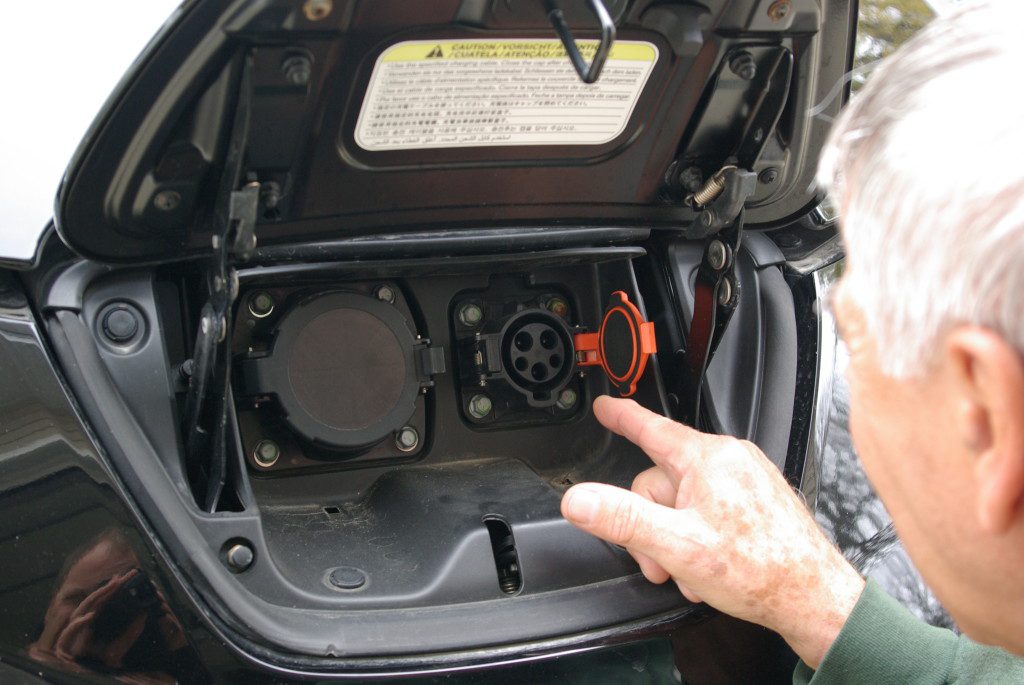
(Decorah resident George Hagen shows us the Nissan Leaf charging ports.)
Most EVs (only electric – not hybrid) have a rough average of 30 to 80 miles available without a charge, and Hybrid EVs that also operate on gas have ranges widely expanded beyond that. According to recent US Department of Transportation Federal Highway Administration surveys, well over half of commutes and daily-use car trips in the US are under 30 miles roundtrip. Even with a sizable amount of commutes averaging 40 miles, there’s huge potential for EVs. Just think: All your quick trips can be done in a vehicle that requires no gasoline, and can charge anywhere a standard plugin is located – we think that idea is pretty cool!
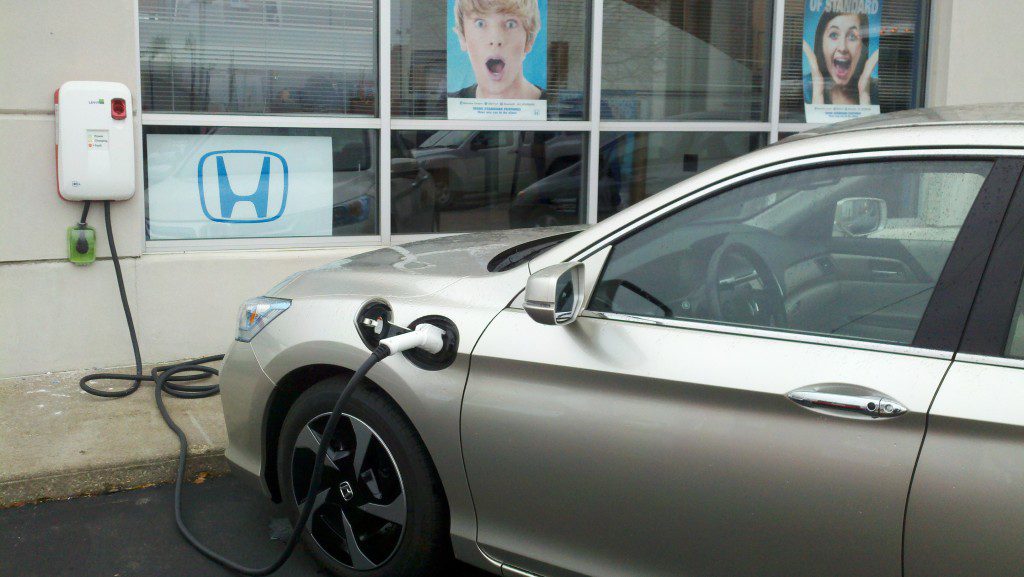
(Photo courtesy of Honda Motorwerks)
Many of our readers are familiar with Chris Schneider (aka The “Hybrid Guru”) of La Crosse’s Honda Motorwerks. Chris has been fueling the alternative vehicle movement in the Driftless Area for years and is an incredible source of information, and of course vehicles. A recent adventure included a trek across the state of Wisconsin to deliver a fully electric Nissan LEAF EV, which is quite an adventure considering that the LEAF has average range of about 80 miles. To top it off, the vehicle was being delivered to Milwaukee, so it was decided that a natural gas vehicle (NGV) would chase for the return trip – just to up the alternative fuel vehicle fun! With the range in mind, the trip required four stops for charging, three of which were about the standard amount of time for a coffee or lunch break. The trip was a grand success, and proved that EVs, although still having limited ranges, can make longer and longer trips as charging technology increases as well. Honda Motorwerks has been a regional and national leader in the use of alternative energy vehicles for years – and Chris is quick to point out that the Decorah area is full of early adopters. In fact, seven of the first 10 EVs that Motorwerks brought into the region years ago all went to the Decorah area.
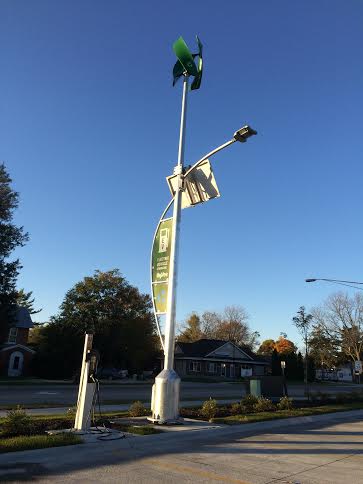
(Electric Charging Station at HyVee, Iowa City – free for customers!)
Most of the major car manufacturers are now making, at the very least, a hybrid electric/gas vehicle – and many are making strict EVs like the Nissan LEAF or Ford Focus EV that run on electricity only and, as mentioned, can be charged on a standard household plug-in (usually taking a few hours to overnight to reach full capacity). But many vehicles are charged more rapidly by different “level” chargers, which are becoming more common across the country – even in places along Chris Schneider’s Wisconsin road trip like Middleton, Madison, and Waukesha. Level 3 charges can bring charging times down to under half an hour for many models. Some commercial recharging locations require small fees for electricity (a couple dollars) while companies like Tesla are creating their own networks of charging stations that provide the power for free – as an incentive to buy their EVs.
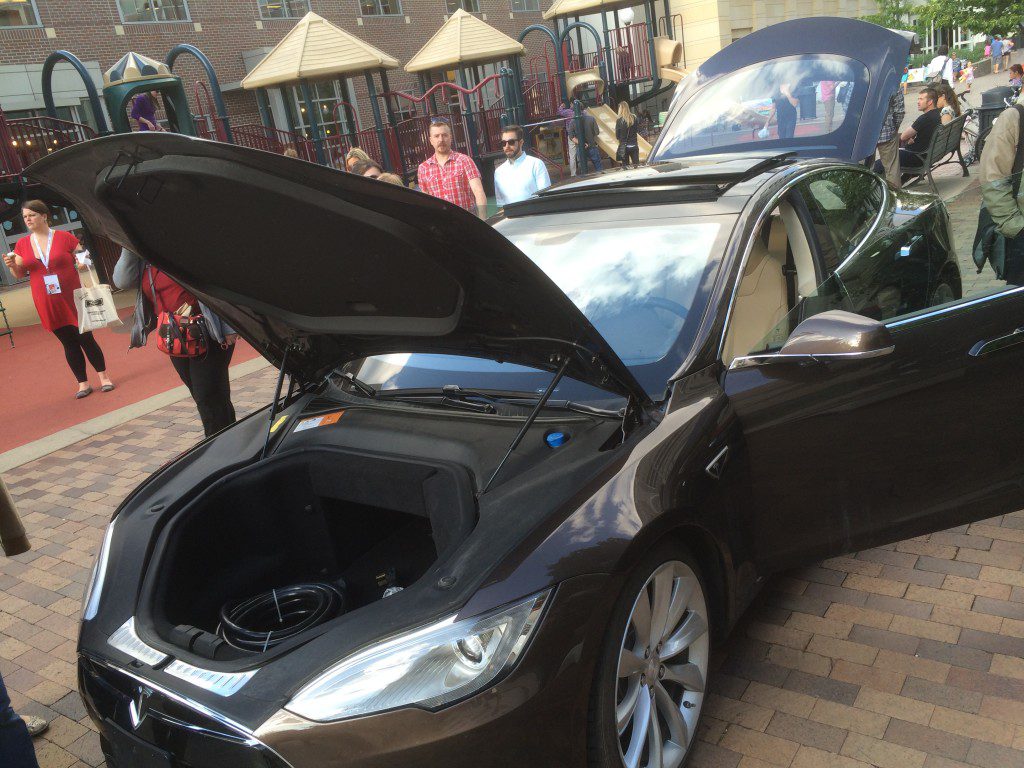
(Tesla Model ‘S’ on display on the Iowa City PedMall during EntreFest, May 2015)
There are a lot of pro and some con points that could be made when considering EVs – from range to environmental to battery technology, and of course, that a large part of the electricity supply still comes from fossil fuels. But we think there is a unique place in our society right now where electric vehicles can truly help “bridge” the road to energy independence. Here at Inspire(d) HQ, we installed a small solar system (eight panels – about 2kw) just about a year ago. We’ve seen a really nice decrease in our monthly electricity bills, but more importantly, it has also helped us to be even more aware of our electricity usage – and the really cool fact is that when we walk out to our garage and the sun is shining – we know we’re making electricity! It really is an amazing experience to know you’ve lessened your dependence on fossil fuels by any amount. As we think about how many miles we drive – and especially those local miles running kiddos around and doing errands, we can see where an electric vehicle could make a lot of economic sense.
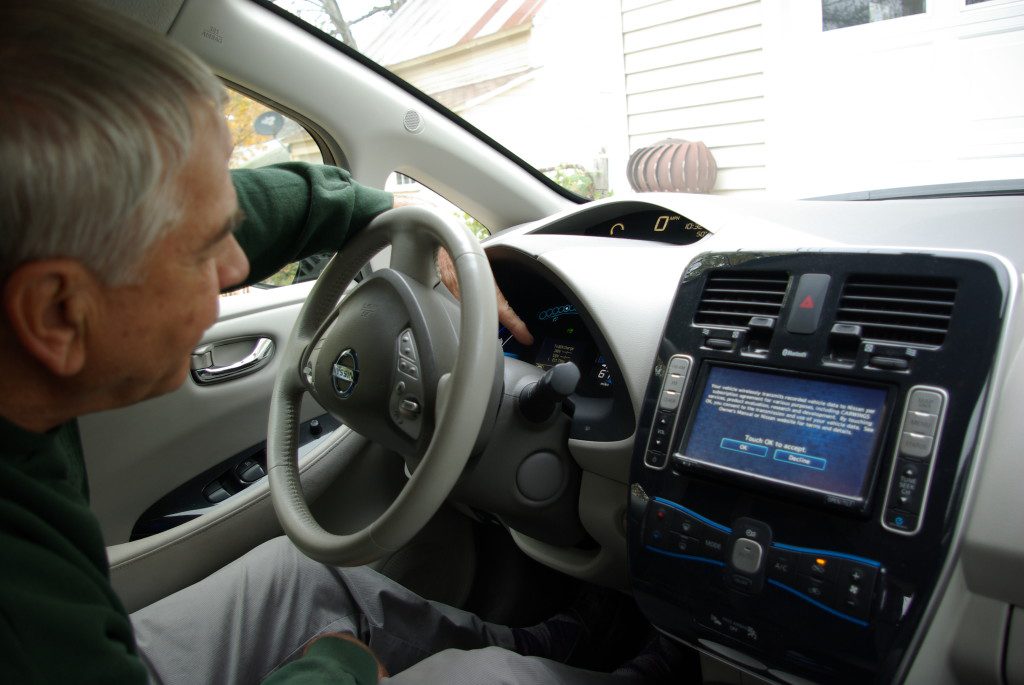
(George Hagen showing us the interior controls of the Nissan Leaf)
Decorah residents George and JoAnn Hagen agree. They have been big supporters of alternative vehicles for several years. George cites his background working as an engineer on conservation projects for Chevron in the late 1970s as sparking his personal interests. A 1980 Datsun was the first vehicle he owned that reached 40mpg, and that sparked a string of vehicles over the years that strived for economic impacts, including the Honda Insight – one of the first hybrid vehicles available in the US around 2000.
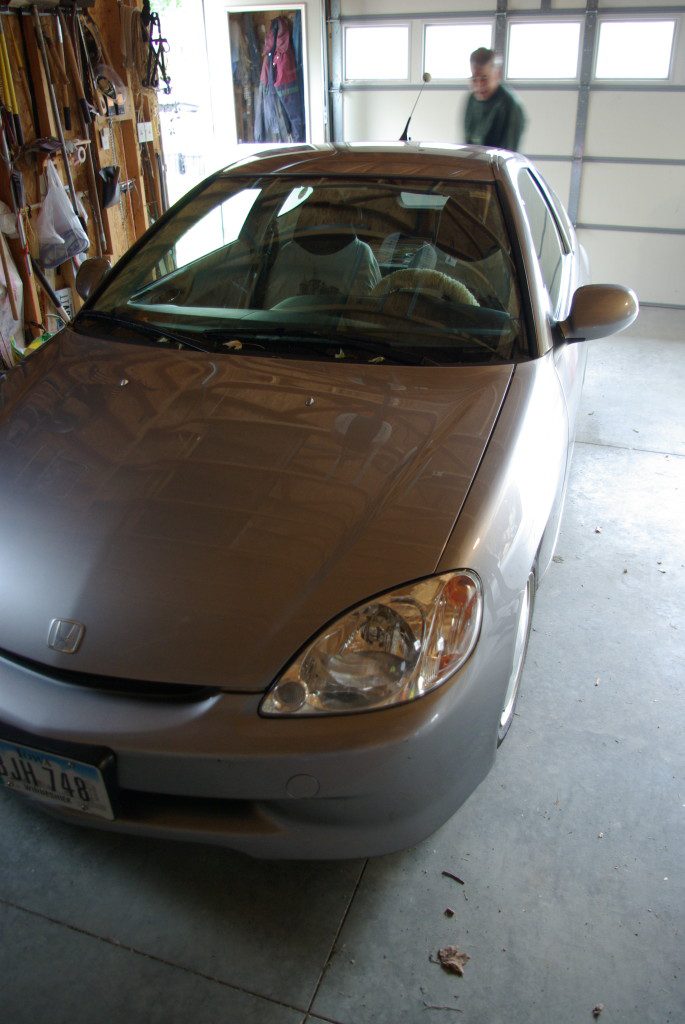 George still proudly garages their 2000 Honda Insight and is quick to point out that it was also one of the first four to make it to this part of the country via Honda Motorwerks in La Crosse. A Toyota Prius followed in 2005, and in October of 2014 the Hagens acquired their Nissan Leaf – the first 100% electric hybrid they’ve owned. Despite varying experiences on range of trip with the Leaf (both George and JoAnn comment that NE Iowa’s Hills take a toll on the EV’s range!) its clear that the vehicle is fun to drive and certainly does well on local trips, with plenty of power and take-off for around town as well as short highway trips. The Hagens also have a large Solar PV array on their garage and home, so again, the ability to produce one’s fuel for driving comes full circle with the Nissan Leaf.
George still proudly garages their 2000 Honda Insight and is quick to point out that it was also one of the first four to make it to this part of the country via Honda Motorwerks in La Crosse. A Toyota Prius followed in 2005, and in October of 2014 the Hagens acquired their Nissan Leaf – the first 100% electric hybrid they’ve owned. Despite varying experiences on range of trip with the Leaf (both George and JoAnn comment that NE Iowa’s Hills take a toll on the EV’s range!) its clear that the vehicle is fun to drive and certainly does well on local trips, with plenty of power and take-off for around town as well as short highway trips. The Hagens also have a large Solar PV array on their garage and home, so again, the ability to produce one’s fuel for driving comes full circle with the Nissan Leaf.
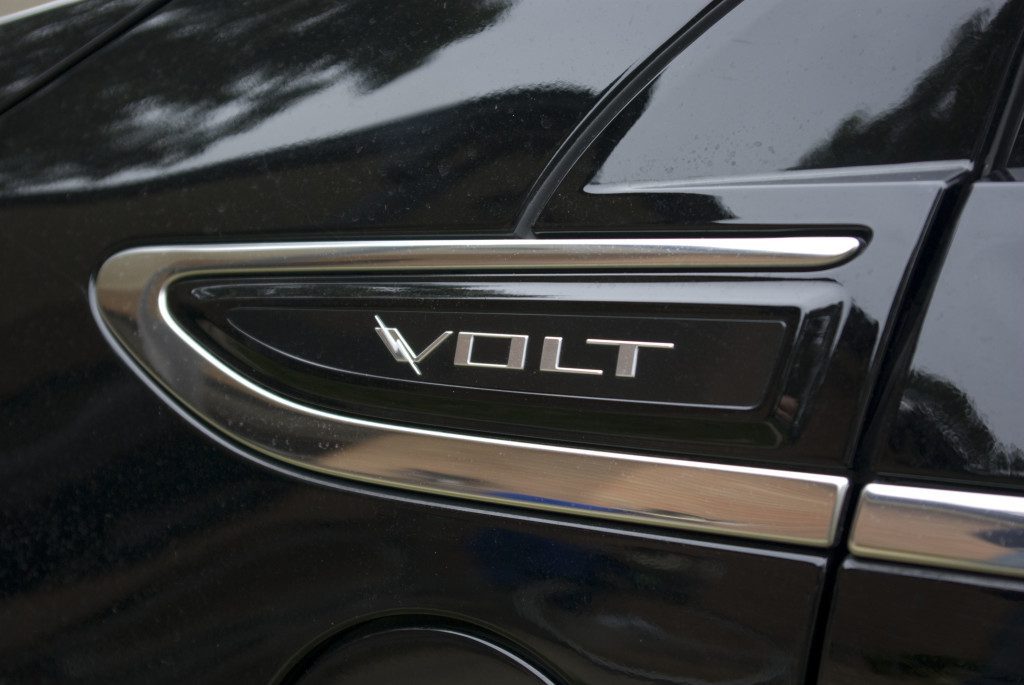 Meanwhile in Decorah, more than a couple families have invested in the Chevy VOLT – a hybrid gas/electric vehicle that allows for a smaller electric-only range which is then assisted by a gas powered generating “engine” that enables further distance. Ben and Padrin Grimstad were kind of enough to give us a few minutes to check out their VOLT, which they – and their high-school aged daughter – enjoy driving. The electrical charging system allows for a nice around-town range, but isn’t necessary to use the vehicle, which still obtains excellent mileage without regular plug-in charging, as most hybrids do.
Meanwhile in Decorah, more than a couple families have invested in the Chevy VOLT – a hybrid gas/electric vehicle that allows for a smaller electric-only range which is then assisted by a gas powered generating “engine” that enables further distance. Ben and Padrin Grimstad were kind of enough to give us a few minutes to check out their VOLT, which they – and their high-school aged daughter – enjoy driving. The electrical charging system allows for a nice around-town range, but isn’t necessary to use the vehicle, which still obtains excellent mileage without regular plug-in charging, as most hybrids do.
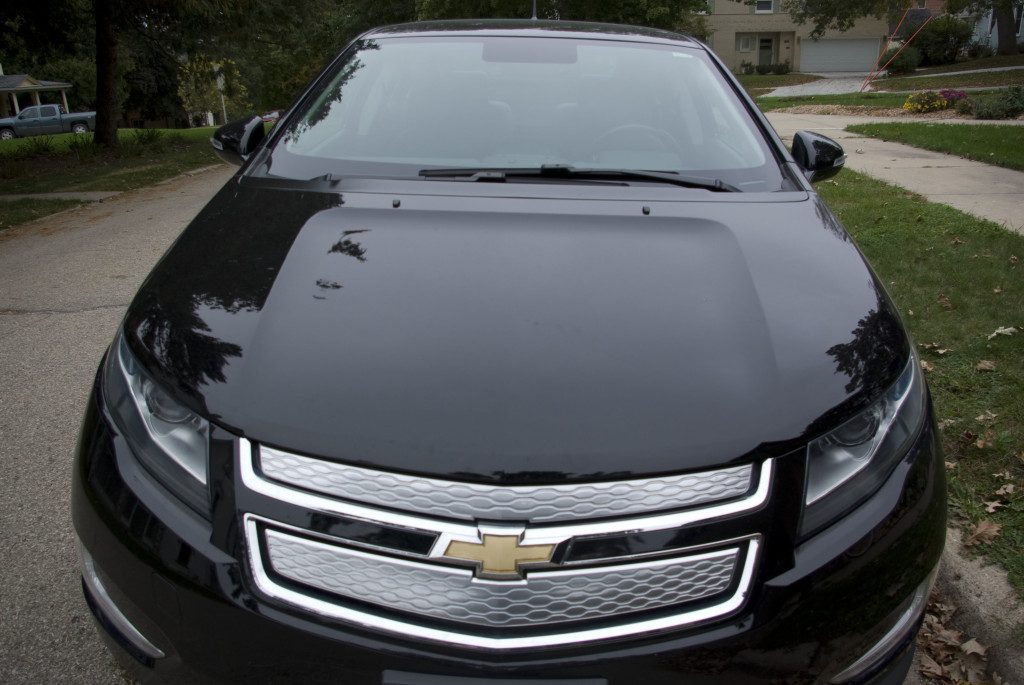 Ben says the car is fun to drive, with plenty of pick-up and acceleration, and fun on-board tools and design to let the driver see what is going on with the vehicle. As a local business owner, he also enjoyed being able to purchase the car from an in-town dealer, and that the family’s additional investments in solar power are paying off in multiple ways, like partially powering their VOLT.
Ben says the car is fun to drive, with plenty of pick-up and acceleration, and fun on-board tools and design to let the driver see what is going on with the vehicle. As a local business owner, he also enjoyed being able to purchase the car from an in-town dealer, and that the family’s additional investments in solar power are paying off in multiple ways, like partially powering their VOLT.
Personally, one of my biggest surprises in researching EVs has been both the performance, and surprisingly good ride of these vehicles. They really do have a different ride and solid feel because of the additional weight of batteries and generally shorter wheel base. Combining their low-to-no-gas mileage ranges with the fact that many Driftless Region residents and businesses have installed solar arrays, EVs are becoming a more practical choice every day.
As more EVs hit the market, expect to see local businesses offering EV Charging stations and specific parking spots as well – we’ll be on the lookout to see who leads the way! We love the EV concept here at Inspire(d) HQ. Granted, like any vehicle, the investment is not small, but the benefits are certainly beginning to stack up. Who knows – we may be delivering magazines in a Solar powered EV soon! Vrrrrooom vrroooom!












